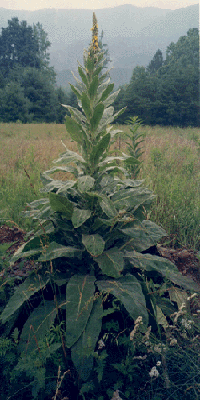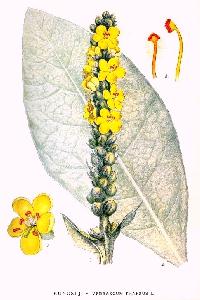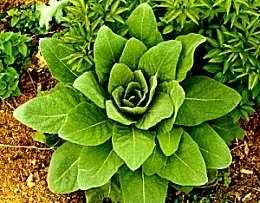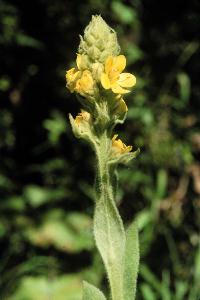

MULLEIN, PUNCHON, OR GORDOLOBO
Verbascum thapsis
By: DJ

This interesting plant, is amazingly versitile. It is a medium to large, showy rosette of large, elongated ovate leaves which are covered with a fine, fuzzy softness...small hair-like structures (the medium to large.. can be from 6 inches across to as much as 2 ft. across... depending upon the moisture it receives). This plant is a bi-annual.. the first year of it's growth being limited to a very beautiful rosette of leaves, and then the second year, it pushes skyward, creating a "bayonette" of brilliant small yellow flowers, which circle the spire, and bloom and alternately wither and become seed pods. This process of blooming lasts nearly a month or sometimes a bit longer. Mullein is a prolific seeder, and each seed capsule can have fifty or more seeds in each .
You've seen the plant even though you may have not recognized it. Some mistakenly refer to mullein as "lamb's ears." ("Lamb's ears" is the entirely different two-foot tall, strictly ornamental plant Stachys lanata). The four to eight-foot mullein stalks boast velvet leaves and yellow flowers and practically blanket every slope, roadside, field and meadow outside the city limits from June to September. Mullein is one of the "Top 5" herbs for hacking coughs. It works best when the cough is tight, dry and "unproductive" (i.e., not producing a lot of mucus). Once the infection and tightness have lessened, you should cut back on mullein and choose another tea which can bring up the mucus (such as licorice, slippery elm, ginger or yarrow.)
Mullein grows in old fields, roadsides, and disturbed habitats throughout the United States It does well in dry, sandy conditions, especially in alkaline soil, so it's especially common near the seashore. Archeologists sometimes look for Indian sites where there's lots of mullein, because the lime from the Indian shell piles increases soil alkalinity, encouraging this plant to proliferate.
| Mullein flowers have a very similar chemical constitution to the leaves but are used in different ways. One common use is in an ointment. Make the ointment by filling a flask with mullein flowers and covering with olive oil. Set this in full sunlight for 21 days, strain out the flowers and store in a smaller bottle. Use this oil for earaches, bruises and as an anti bacterial on surface infections. Pouring boiling water over the flowers will extract their bright yellow color and can be used as a dye for yarn and cloth. If dilute sulfuric acid is added to this yellow dye then color the cloth a permeate green and by adding alkali to the green dye you get a brown color. Thus you get three different colors with one flower! |
 |
Mullein tea provides vitamins B-2, B-5, B-12, and D, choline, hesperidin, PABA, sulfur, magnesium, mucilage, saponins, and other active substances.
People use the tea as a beverage, but it's best known as one of the safest, most effective herbal cough remedies. Mullein is an expectorant, and a tonic for the lungs, mucus membranes, and glands. An infusion is good for colds, emphysema, asthma, hay fever, and whooping cough. Strain the infusion through a cloth, or the hairs may get stuck in your throat and make you cough even more. Laboratory tests have shown that it's antinflammatory, with antibiotic activity, and that it inhibits the tuberculosis bacillus. The Indians smoked dried mullein and coltsfoot cigarettes for asthma and bronchitis, and indications are that it's effective: It works for bronchitis.
The tea is also an astringent and demulcent. It's good for diarrhea, and it's been used in compresses for hemorrhoids since it was recommended by Dioscorides centuries ago. It's also supposed to help other herbs get absorbed through the skin. Pliny of ancient Rome, Gerard in sixteenth century England, the Delaware Indians, and country folk in the South used the heated leaves in poultices for arthritis.
DOSAGE: The traditional dosages are as follows...

Young plant is only the basal rosette you see here. |

Flowers of second year plant |